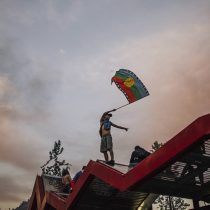
Nicol hasn’t had his left eye checked since March. About the same time as Albano. Philip has been a little more lucky and last week saw the protesist for the first time in just over two months.
All three were left one-on-one after being hit by balinese and tear-jerms fired by security forces during the protests sparked in October, which were killed with thirty dead and staggered the foundations of what was once considered The most stable country in Latin America.
All three sit down “in absolute abandonment” and fear that their ailments will be aggravated: the pandemic of the new coronavirus has put in “stand-by” the government eye repair program in which they participate and there is no date for its reactivation.
“I was called overnight to cancel my appointment and no one has contacted me to ask me how I am,” he laments Efe Albano, a 41-year-old nurse who on October 21 was on a march healing wounded when he was shot.
The pellet shattered his glasses and the glass stuck in his left eye, shattering his cornea. The wound has been bothering him for a few days and he believes he is forming a cataract, but in Iquique there are no specialists from the program and he cannot travel to Santiago because of the restrictions imposed by the pandemic.
“At first we were talked about, but now we have been forgotten,” says Albano, who is awaiting a third operation in June, although he believes that they will cancel it given the explosive advance of the coronavirus, which in the country already registers more than 100,000 infected and 1,200 dead.
“All resources have gone to covid-19, I understand, but we also need help. They were the ones who maimed us,” says Efe Philip.
In his case, it was a tear that hit his face when he was demonstrating in Plaza Italia. The gas mask saved his life and the blow caused a ruptured skull and left eyeball, which he can barely open.
“Epidemic of eye trauma”
The eye-wounded are a kind of martyr for the protesters, who consider them proof of the police brutality that was experienced in Chile and that was denounced even by the United Nations.
The “UTO” – the diminutive with which the Eye Trauma Unit of Salvador Hospital, where most of the wounded came and treated – was those days a cold-eyed youth: “For my profession I have been in many hospitals and I had never seen anything like it, it was a war zone,” Albano recalls.
According to the National Institute of Human Rights (INDH), 460 people were blinded, two of whom went blind and 35 suffered total loss of one eye.
Although the Chilean government initially spoke of “isolated accidents”, days later and in the face of the undeniable avalanche of cases, it launched an aid plan, which the victims describe as “inadequate”.
The program has a team of ophthalmologists and surgeons, a psychologist and an occupational therapist, according to the Eye Trauma Victims Coordinator, who says that only emergencies work right now.
Efe repeatedly contacted project managers, but received no response.
“The children were ruined by their lives and the government must help them for life, not just when they finish their treatments,” Efe is told by the president of the association, Marta Valdés.
From the confinement at her home in Santiago, Valdés deals with a teenage son who was blinded by a tear-faced child and with other injured people who come to her due to the impossibility of getting prescriptions to buy medications for the cancellation of appointments.
He also warns that there are at least two young people at risk of losing their eyes healthy because they are forcing him too high and have very high intraocular tension: “We are very afraid that there is not only one Gustavo and a Fabiola,” he says in reference to the two people who were blinded by gunshots from the agents.
More than a physical wound
Nicol starts shaking just thinking about Plaza Italia, but he knows he’ll have to come back at some point. He is a photojournalist and his specialty is conflict.
He lost 95% of the vision in his left eye, but that doesn’t seem the hardest thing to him. Six months later, he has nervous tics and panic attacks. The program psychologist doesn’t give up and has had to find a specialist who charges her $80 per session. He knows that most of his peers nor they can afford it.
“The kids are all packed and doped, give them very strong medication and barely control them,” says the 30-year-old who doesn’t plan on going back to UTO until the pandemic passes.
“We have had colleagues who have been with covid patients in the emergency room, without any shelter. That represents in all its expressions the negligence and state abandonment,” he adds.
Philip is also heavier with the psychological wound. He had to remove the large mirror he had in his bedroom and placed it in a corner of the living room. He’s still not able to look at himself.
“I’m 40 years old, since I was 18 I’m a welder in mining. I can’t work anymore, I’m a risk. I’m going to have to reinvent myself, I know I can do it, but the state isn’t giving me the conditions to do it,” he says.
To the pain of injury and the anguish itself from confinement, the impotence is added by the slow progress of investigations. They have little confidence in Chilean justice and are willing to resort to international courts.
“We will not rest until there is truth and justice. Maybe we’re not going to find who was shot, but we do know exactly who gave the orders,” says Valdés.





